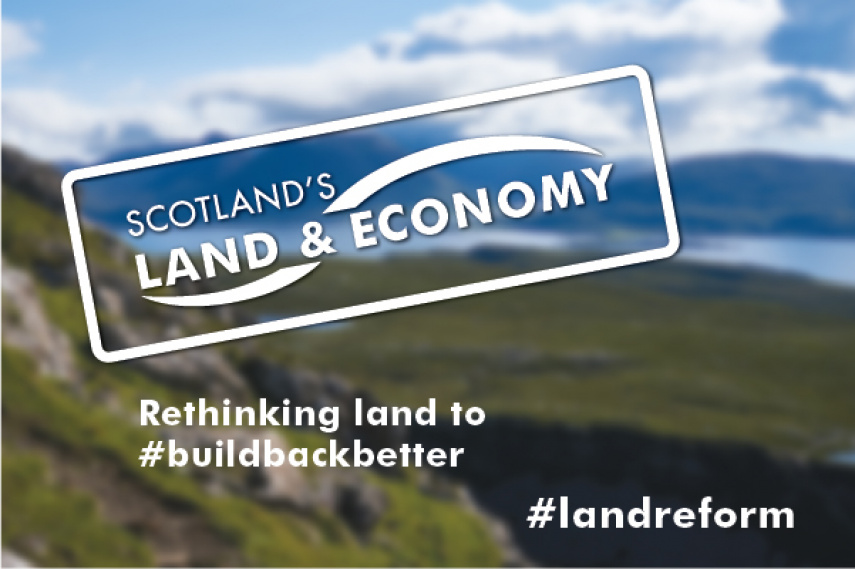
A Response to ‘Putting land back into the economic model’
Deryck Irving

As part of the ‘Scotland’s Land & Economy’ series exploring the fundamental role of land in achieving Scotland’s post-pandemic recovery and renewal, we are publishing a range of guest blogs from leading thinkers across the UK. The purpose of these blogs is to stimulate ideas and debate and do not necessarily represent the view of the Commission.
Deryck Irving, Director of Strategy and Development at the Central Scotland Green Network Trust*, explores the themes raised in a recent blog and examines how immediate action is possible to tackle the issue of vacant and derelict land.
I really welcome the chance to write this short response to Shona Glenn’s blog ‘Putting land back into the economic model.’ There is one specific point in Shona’s piece that I would like to build on:
‘Scotland’s legacy of vacant and derelict land – much of it in public ownership – presents one opportunity where immediate action is possible.’
This focus on the legacy of urban change and industrial activity is important. These sites are both a blight on communities and a genuine opportunity for positive change. From an environmental perspective, vacant and derelict land (VDL) has the potential to:
- contribute to action on climate change – both mitigation and adaptation
- create accessible, safe and usable greenspace for communities
- develop key links in wider habitat and access networks
- provide the green infrastructure which will allow other forms of development to take place
- support new green jobs, volunteering and skills development.
But VDL is only one aspect of the dysfunctional relationship that we have with land in Scotland. Unused and underused land is found throughout our town and cities and out into the rural areas. It is hard to comprehend why, in a country which draws so much benefit from the quality of its land, we are willing to accept large quantities of land lying vacant or having no discernible function.
At one extreme, we have derelict sites – spaces so severely damaged by past use that they are deemed unsuitable for development – but we also have thousands of hectares of land which is sitting waiting for a future use that hasn’t yet materialised. We also have significant areas of green desert – spaces around residential and commercial developments which are managed to keep them ‘tidy’ but which have no function other than as a depressing setting for buildings.
It’s not impossible to change this wasted land; to give it a range of productive and positive uses; to create an environment that enhances communities and neighbourhoods; to create places that attract business and which nurture people.
So, what is stopping things from changing?
Resources
There is a case for more targeted investment to turn these spaces around. The derelict sites, in particular, are likely to need an initial capital spend to address the site conditions which are preventing them from being used. But it is important to remember that these sites are not cost-free – degraded, low quality sites have a negative impact on surrounding areas, attracting anti-social behaviour and impacting on people’s health and wellbeing.
Creating productive uses for these sites has the potential to generate local economic activity as well as creating stronger communities and sense of place. These benefits will outweigh the costs of all but the most complex and contaminated sites.
Unhelpful drivers
There are a series of drivers which have led to, and which sustain, the current position.
One is simply inertia and a reluctance to change. We manage land around housing and business parks like that because ‘we’ve always done it that way’ and because there are contracts in place that deliver regular grass cutting. At a time when everyone is acknowledging that the world post-Covid will operate differently, doing things because ‘that’s what we do’ is an increasingly high risk strategy (particularly when it is clear that the status quo wasn’t working pre-Covid).
Another is ‘hope value’. Much of our VDL is being held in its current state by an expectation that it will be valuable for development in the future. While this is true for some sites, the ‘values’ assigned to these sites seem to have no basis in current reality and we have sites which have lain unused for decades. Allied to hope value is a reluctance to allow temporary use of sites in case this prevents the hoped-for long-term use of land. This leaves sites uncared for and unused even when positive local uses can be identified.
What are we doing about this?
Even before the current pandemic focused attention on the importance of local environments and on the unacceptable levels of inequality in access to quality spaces, there was a great deal of activity underway.
We are seeing changes to the management of green deserts – driven by biodiversity commitments and interest in a wider range of community spaces. Local Authorities are recognising specific VDL sites as community wildlife assets (while acknowledging that some work is needed to make the sites safe and welcoming).
We are finally beginning to recognise and capture the wider value of land and of action to improve it. The Scottish Conservation Finance Project’s £1 Billion Challenge Route Map includes proposals for a privately financed Vacant and Derelict Land Fund generating investment returns from environmental and social benefits. At a more local level, the Wishawhill Wood Pump Track demonstrated a measured reduction in anti-social behaviour with significant savings for emergency services.
The Central Scotland Green Network Trust is coordinating partnership work with the Scottish Land Commission, SEPA and Scottish Natural Heritage aiming to identify the best opportunities to tackle long-term, persistent derelict sites in urban Scotland through ‘greening’.
Who needs to be involved?
Action is needed at all levels and from a wide range of players. Collaboration and partnership will be key.
Scottish Government can determine the desired direction of change and set national priorities. A new approach is likely to need some changes to legislation and to how Government resources are used.
This national agenda then needs to be interpreted and actioned regionally and locally through land use and spatial planning and through economic development decisions. Local Authorities are at the heart of this process but it also needs support from key public agencies and the emerging Regional Land Use Partnerships. Public sector landowners and land managers have an important role in developing and demonstrating a new way of thinking about their land. Private sector organisations are even more important since much of our wasted land is in private ownership and private sector finance will be key to unlocking much of our VDL for productive use.
If we are to genuinely reap the benefits of tackling wasted land then communities must be involved. Community empowerment increases local resilience and has direct wellbeing benefits. Third sector organisations like my own are often the catalysts for change, the facilitators of partnership working and perform a vital role in supporting community involvement in the processes of change.
Here’s to a brighter and greener future!
*The Central Scotland Green Network Trust is an independent charity working with a wide range of private, public and third sector partners across Scotland to turn ideas into tangible change – planning and delivering positive action to achieve Scotland’s climate change ambitions and to create healthy, sustainable and climate resilient places.